Physical Address
304 North Cardinal St.
Dorchester Center, MA 02124
![]() For videos accompanying this chapter see ExpertConsult.com . See inside cover for access details.
For videos accompanying this chapter see ExpertConsult.com . See inside cover for access details.
The upper limb bud develops from the flank of the developing embryo from day 26. Somatic lateral plate mesoderm forms the skeleton and mesoderm from somites migrates in to form the musculature and contributes to the vascular system. Fibroblast growth factors initiate development along three axes with the interaction of signaling centers: proximodistal axis controlled by the apical ectodermal ridge; anteroposterior (radioulnar) controlled by the zone of polarizing activity (ZPA); and the dorsoventral (or dorsovolar) controlled by the wingless gene encoded protein ( Fig. 45.1 ). Genes and their encoded proteins control growth and differentiation and act as messengers between signaling centres and developing cells. Mutations, whether inherited or spontaneous, disrupt secreted proteins, ligand factors, and transcription factors. Environmental factors including drugs (e.g., thalidomide), radiation, nutrition, and infection can also disrupt molecular pathways.
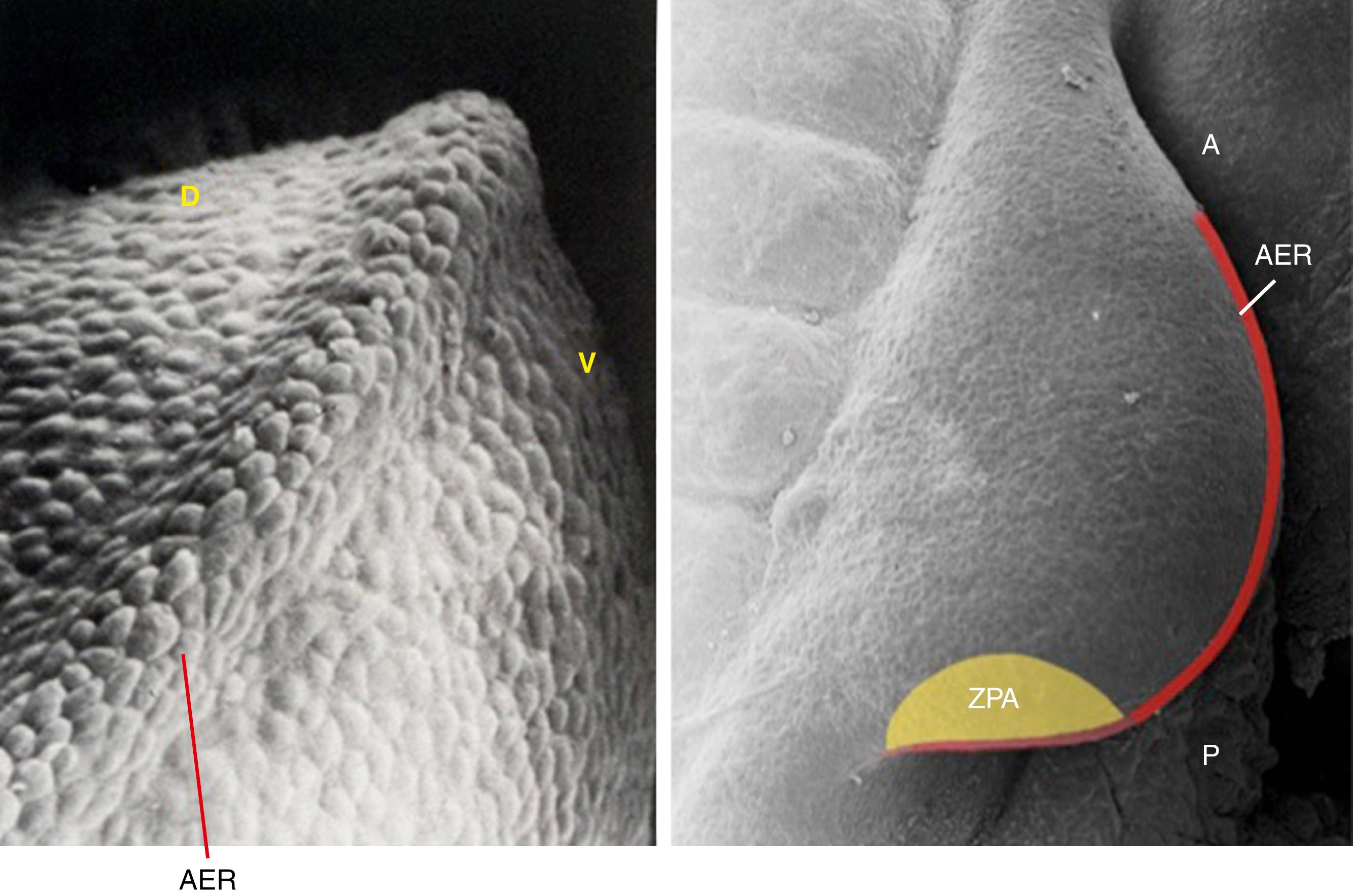
The limb bud contains a core of proliferating mesenchymal cells covered by ectoderm which thickens at the tip to form the apical ectodermal ridge (AER). The spinal nerves grow into this and an initial capillary network coalesces into a main stem artery, which drains into a marginal vein. The mesoderm organizes into the ZPA and a progress zone (PZ). By day 33, there is a paddle-shape limb with prechondrogenic condensations at sites where cartilaginous skeletal elements will form. Chondrogenesis takes place and myoblasts migrate into the limb and aggregate into ventral and dorsal muscle masses by day 36. At 6 weeks, digital rays form giving the hand a webbed appearance, and at 7 weeks the upper limb rotates by 90 degrees and the elbow flexes bringing the palm anteriorly. Ossification occurs in parallel and apoptosis between rays leads to tissue involution and digital separation. Thus by week 8 a miniature adult upper limb is formed ( Table 45.1 ).
| Time Point | Upper Limb Development |
|---|---|
| Day 26 | Limb bud first appears |
| Day 33 | Paddle-shaped hand present |
| Day 42 | Digital ray present Hand assumes a webbed appearance |
| 7th week | Upper limb rotates 90 degrees laterally to bring the palm anteriorly Elbow begins to flex Ossification begins Involution of tissue between fingers occurs by apoptosis |
| 8th week | Upper extremity resembles miniature adult upper limb |
Research into the developing chick embryo has provided a great deal of information on the process of limb patterning. In the proximodistal axis, the AER is formed by the Wnt7a gene and secretes FGF 2, 4, and 8 stimulating proliferation and bud outgrowth. AER resection leads to a truncated limb, whilst AER grafting extends the limb. In the anteroposterior (radioulnar) axis, the ZPA is on the ulnar side between the polarizing region (posterior limb bud mesenchyme) and limb bud tip mesenchyme. This secretes Shh, which is the product of the sonic hedgehog gene. If the polarizing region is grafted anteriorly, a mirror set of digits results. In the dorsoventral axis, the somite provides a dorsal signal to the mesenchyme, which dorsalizes ectoderm. Wnt7a from the dorsal ectoderm and Lmx1b from the mesoderm coordinate tendon and ligament formation. Other important genes in limb patterning include HoxD ( HoxD13 mutations are associated with central polydactyly) and Gli3 (mutations lead to polydactylies).
There have been multiple attempts to classify congenital hand differences, however an entirely inclusive system remains elusive. A largely morphological system, first proposed in 1968 then refined in 1976 and 1983 by Swanson et al, was adopted as the standard by the International Federation of Societies for Surgery of the Hand in 1976 and remains the most widely used ( Table 45.2 ). However, approximately 10% of congenital hand differences do not fit into this classification, and some anomalies fit into more than one category. Extensions to this classification include those by Knight and Kay in 2000 and Upton in 2006. More recently, Tonkin in 2013 presented a classification system based on causation taking into account the growing body of knowledge from molecular biology. He categorizes anomalies into malformations (an abnormal formation of tissue resulting from abnormal cell function), deformations (an insult to cells that have already formed normally), and dysplasias (a lack of normal organization of cells into tissue). Disruptions, alteration of tissue that is already formed, are considered alongside deformations. This system is growing in its popularity and application.
| Failure of formation | Transverse arrest Longitudinal arrest |
Complete deficiencies Intercalated deficiencies Radial (preaxial) Central longitudinal deficiency Ulnar (postaxial) longitudinal deficiency |
| Failure of differentiation | Soft tissue Skeletal |
Syndactyly Camptodactyly Trigger thumb Clasped thumb Clinodactyly Symphalangism Synostosis Arthrogryposis Windblown hand |
| Duplication | Ulnar polydactyly Central polydactyly Ulnar dimelia |
|
| Overgrowth | Macrodactyly | |
| Undergrowth | Brachydactyly Thumb hypoplasia |
|
| Constriction ring syndromes | Groups 1–4 | |
| Generalized skeletal abnormalities | Achondroplasia |
A normal web ends at the midproximal phalanx on the volar side and an abnormal continuation beyond this level is termed syndactyly (Greek syn = together, dactylos = digit/finger). Syndactyly is the commonest congenital hand abnormality, with an incidence of 1 in 1000 live births. It is more common in Caucasians than Africans and affects males more than females (46%–84%). It is familial in 15%–40% and can be unilateral or bilateral (25%–50%). Syndactyly may affect the fingers and/or toes and most commonly presents as an incomplete second web syndactyly in the foot. In the hand, the third web is most frequently involved (50%) (see Fig. 45.2A, B ), followed by the fourth (30%), second (15%), and first (5%) %). A failure of apoptosis or programmed cell death, a process mediated by BMP-4 (bone morphogenic protein), is thought responsible during digit separation from day 41–53.
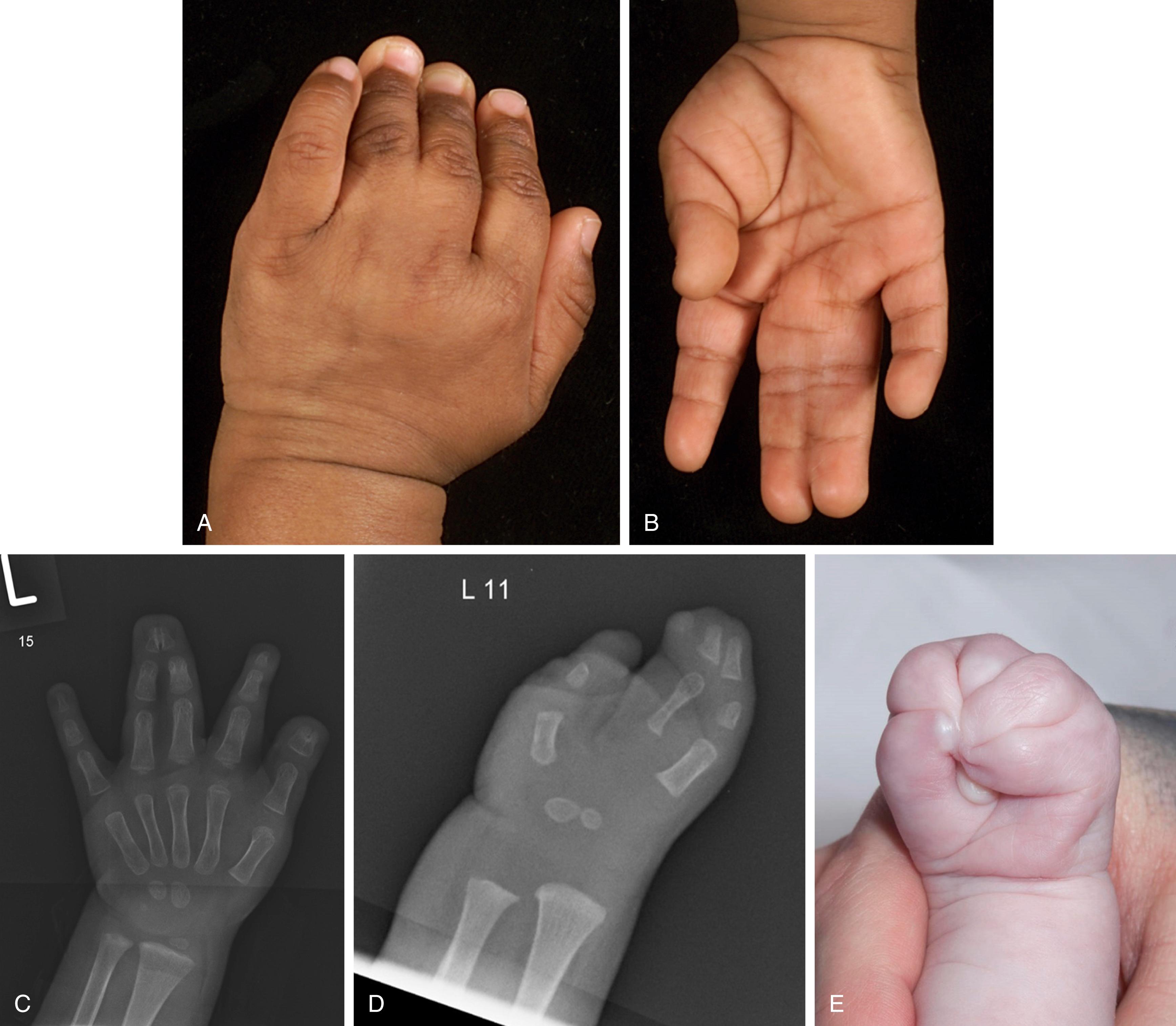
Syndactyly may occur in isolation. However, it also associated with a number of syndromes including Poland, Apert, and Greig syndromes. It can also occur in conjunction with other limb deformities, such as polydactyly and constriction rings.
Syndactyly is classified as follows ( Fig. 45.2 ):
Incomplete or complete (extending to the distal phalanx)
Simple (soft tissue only) or complex (with bony synostosis)
Complicated (a haphazard arrangement of bones with loss of normal ray patterning)
Acrosyndactyly (fusion of digits distally, from the Greek acro meaning “tip,” with proximal fenestrations commonly associated with constriction ring syndrome).
Inspect the syndactylized digits. With complete syndactyly, the nails can be fused with an inward rotation of the digits, which eludes to the presence of a complex distal bony union ( Fig. 45.2C ). The degree of skeletal disruption within a syndactyly tends to parallel the degree of soft tissue abnormality, including that of tendons and digital neurovasculature structures. It is important to examine for the presence of digital creases, which provides valuable information about the passive and active joint range of motions, which may also be abnormal. The status of the joints pre-separation must be established to ensure adequate counseling of patients and their families with regard to the postoperative motion and function. Often a child and family will opt for the correct complement of digital number over function in equivocal cases.
In complicated syndactyly there is more than just a bony synostosis. Often there is a haphazard arrangement including extra skeletal elements concealed within a digit with associated fusions, rudimentary bones, missing bones, abnormal joints, and sometimes cross bones, which can span several rays ( Fig. 45.2D ). It can be uncertain which bones best match with which digits. In acrosyndactyly, there is a complex syndactyly characterized by fusion of the bone distally but not proximally with often fenestrations or sinuses proximally ( Fig. 45.2E ). This is discussed later under Constriction Ring Syndrome (CRS).
Timing is controversial. To reduce anesthetic risk, most surgeons operate when patients are over the age of 1. Delaying separation in this way has the added advantage of larger anatomy, including that of the vasculature. Indications for earlier surgery include syndactyly involving the border digits, i.e., between the thumb and index and the little and ring fingers where tethering of growth can occur due to marked discrepancy in digital length. This can result in compromised function, and in neglected cases flexion contractures. Early release is also advised in cases of complex and acrosyndactly, where bony fusions can also affect growth. The aim is for all possible separations to be complete by school age or around 5 years.
The aim is to achieve both optimal function and cosmesis. Release involves separation of conjoined skin and subcutaneous tissue, ligaments, and bony synostosis whilst preserving the integrity of the neurovascular bundles. Subcutaneous fat may be removed in an effort to facilitate closure and contouring.
Separation can be divided into reconstruction of the web, sides of the digits, and tips including the paronychial folds.
Multiple techniques have been described using volar, dorsal, or a combination of flaps of varying sizes and designs. The web is generally reconstructed with a proximally-based dorsal flap. Grafts are best avoided in the webspaces as they can lead to problems of poor pliability and delayed healing with associated web creep. Large triangular flaps are practical and versatile ( Fig. 45.3 ). They allow for adjustments to be made around abnormal distal branching of digital vessels and avoid transverse scars that can recontract in the future. They must be designed in such a way as to create a gentle slope from dorsoproximal to volar-distal.

Release of the first web involves the use of Z-plasties (four-flap, Fig. 45.4 ), double, double-opposing, five-flap), transposition flaps (from the dorsum of the hand and index or thumb), pedicled and free flaps depending on the defect size following thumb and index separation. It is important to release the fascia on the first dorsal interosseous and the adductor muscles. Sometimes it is necessary to reinsert the adductor muscle more proximally.
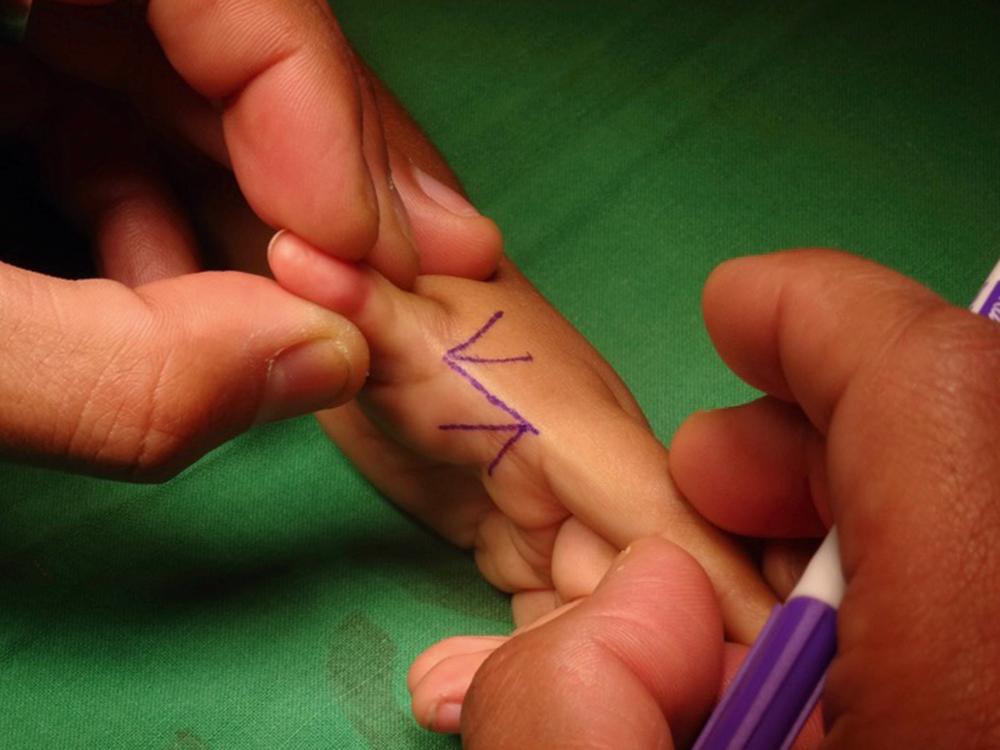
Most commonly interdigitating flaps from the volar and dorsal aspects are used to close the defects along the borders of the digits (see Fig. 45.3 ). Straight-line incisions along the borders should be avoided as they have a high incidence of scar contracture and subsequent digital deformity. A skin graft is usually needed in all but the most minor cases as even in a simple syndactyly skin shortage is at least 36% of the circumference. The graft should be full thickness from the groin, inner arm, or antecubital fossa. Thick split-thickness grafts from the instep can be used in some cases of toe separation. Graft take may be improved with quilting onto the underlying soft tissues, and in the case of complex, directly onto bone. Graftless techniques have been advocated by some as a way of improving skin match and reducing operative time. This approach relies on thinning and undermining interdigitating flaps to permit direct closure. Care must be taken with this method to avoid excessive tension and resultant vascular compromise.
Single-stage releases of both sides of a digit should be avoided as this may jeopardize digital vascularity in cases of anomalous vascular anatomy. For example, in short multiple syndactylous fingers, dominant digital vessels can only exist on the lateral sides of the conjoined fingers. Sometimes it is necessary to sacrifice one of the vessels in a distal bifurcation. The digital nerves can usually be gently separated more proximally.
In a complete syndactyly with separate nails or partly fused nails, on separation of the pulps the skin can generally be advanced to close the resultant defects. In conjoined nails without a ridge, the lateral nail fold requires reconstruction, most commonly with interdigitating flaps from the hyponychium, e.g., Buck–Gramcko “stiletto” flaps ( Fig. 45.5 ). Care must be taken to ensure these paronychial reconstructions are not too bulky and do not leave an excessively narrow tip.
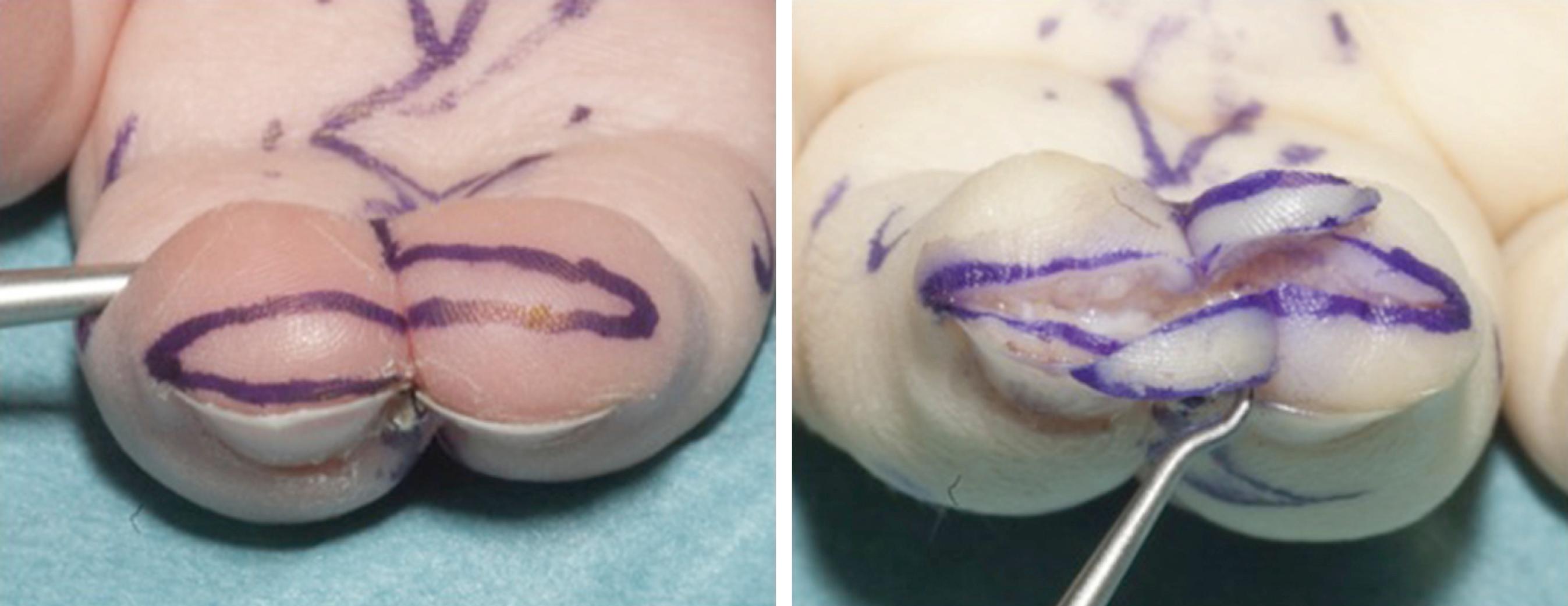
Clinodactyly (Greek clino = deviated, dactylos = digit/finger) is a congenital deformity in the radioulnar plane at the phalangeal level. Incidence is reported as 1%–19.5% depending on the degree of angulation used to define it. It is inherited as an autosomal dominant trait with incomplete penetrance though the exact etiology is unknown. The angulation commonly occurs as a result of a triangular-shaped, “delta” or trapezoidal, middle phalanx ( Fig. 45.6 ), though more rarely the proximal phalanx can be involved. This is formed by an abnormal C-shaped epiphysis (longitudinal bracketed or comma-shaped), the arm of which extends onto the ulnar side of the middle phalanx ( Fig. 45.6A ). The articular surface of the phalanx does not lie perpendicular to the longitudinal axis of the finger. The middle phalanx ossifies later than the other phalanges and latest in the little finger, hence clinodactyly occurs most commonly in the little finger. The thumb is the second most common. Clinodactyly most frequently occurs as an isolated familial abnormality. However, it may also be linked to syndromes including the Apert (thumb), Trisomy 21, Poland, Treacher Collins and Klinefelter syndromes.
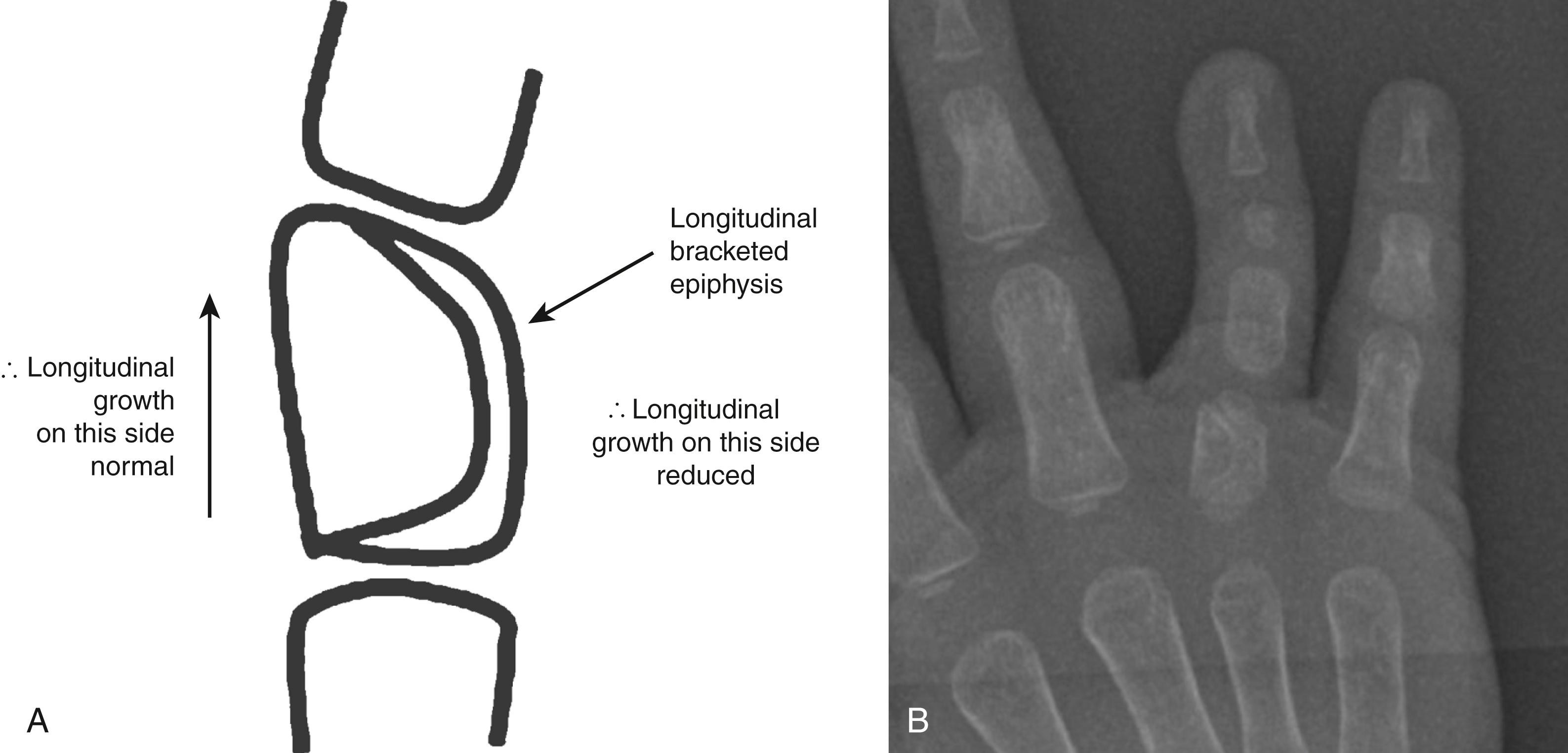
The most common presentation congenitally is in the little finger, with radial deviation of more than 10 degrees, seen at the proximal interphalangeal (PIP) and distal interphalangeal (DIP) joints, and a positive family history. An acquired deformity may occur due to growth plate injury or deviation following syndactyly release. Kirner’s deformity may be mistaken for clinodactyly. However, Kirner’s deformity represents a volar and radial curvature at the DIP joint. It most commonly affects females and appears between the ages of 7 and 14 years, often presenting as a painless swelling at the base of the nail.
A common presenting complaint with clinodactyly is cosmesis as milder forms are not associated with any functional impairment. However, with worsening angulation, function can become impaired. Radiographic assessment allows identification of an abnormal or bracketed epiphysis. The status of the growth plate is an important factor in deciding treatment.
As the abnormality is primarily skeletal and not corrected with growth, there is little role for splintage or stretches. The main indication for surgery is worsening deviation with associated functional impairment. This commonly occurs with deviations of more than 20–30 degrees. Age and the status of the epiphysis are critical factors. If growing, physiolysis with resection of the lateral physis and interposition of a fat graft can achieve good results with reliance then on the finger growing straight and correcting itself. This is best done before the age of 6 years. Durability of this procedure is influenced by the extent of soft tissue release at the time of surgery. Epiphyseal bar resection with fat grafting is best avoided in small triangular-shaped bones with minimal growth potential and best not repeated to avoid premature epiphyseal closure. With persistent deformity or after completion of growth, correction is best achieved via osteotomy procedures. These include a closing wedge osteotomy, where bony wegde is removed from the longer side in order to correct angulation. If length preservation is more critical an opening wedge, reverse wedge or dome osteotomy ( Fig. 45.7 ) may be more appropriate. However, in this form of correction the soft tissue deficit on the shorter side must be addressed in order to facilitate correction and prevent recurrence in the long term. This can be achieved through techniques such as Z-plasties or local transposition flaps. Our preference whenever possible is for an opening wedge or dome osteotomy (see Fig. 45.7 ) with longitudinal K-wire fixation.
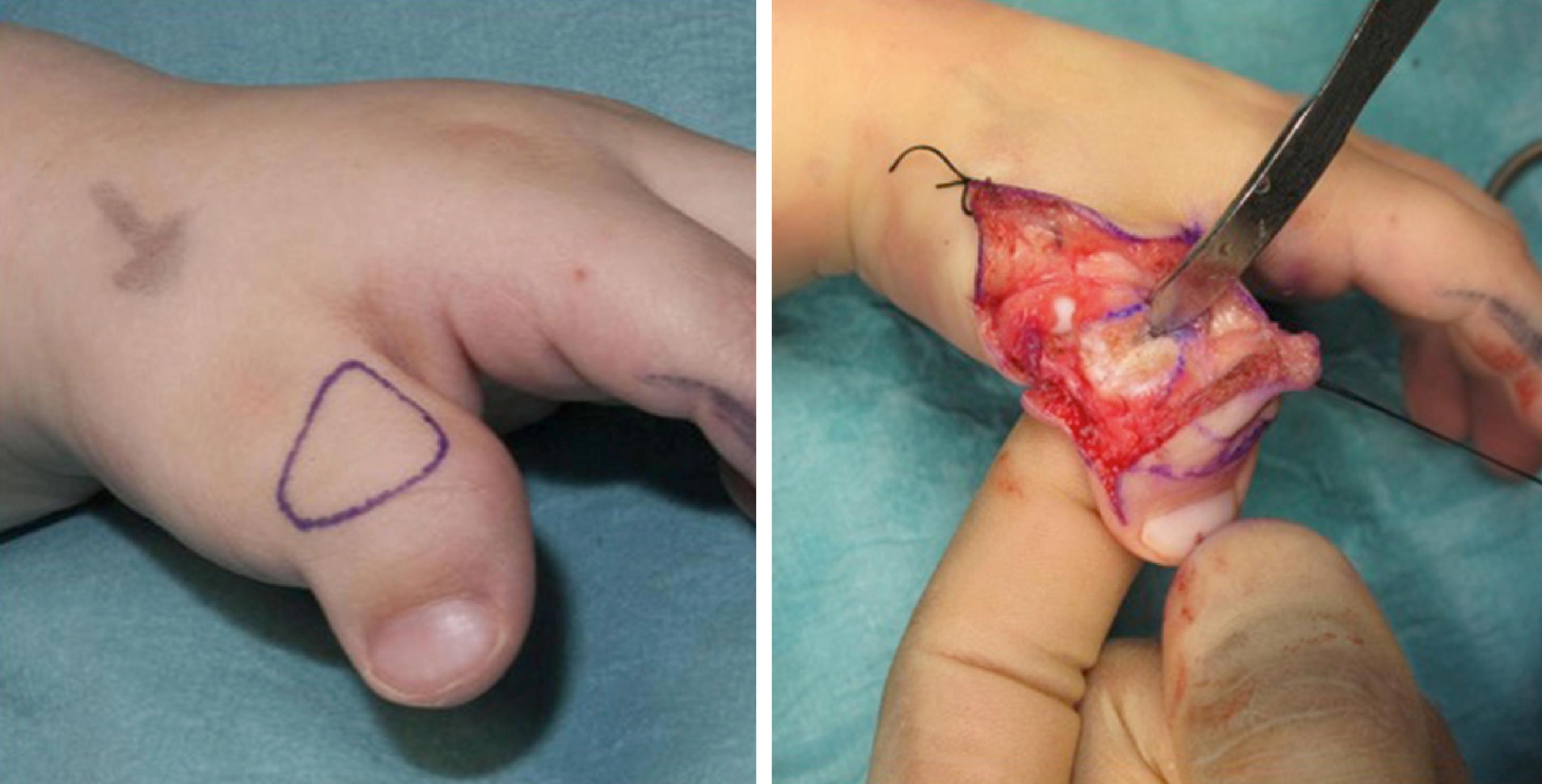
Camptodactyly (Greek kampylos = arched, dactylos = digit/finger) is a congenital flexion deformity of the PIP joint ( Fig. 45.8 ). There are approximately 1 million cases in the UK per year. The little finger is affected most commonly (70%), then the ring (20%), and then the other digits (10%). Bilateral involvement is common and multiple digits can be affected. Two common patterns of presentation exist. Firstly, in the newborn age group worsening during the 1–4-year growth spurt. In this group males and females tend to be equally affected. Secondly, in the adolescent growth spurt between 10 and 14 years of age, in which there is a female preponderance. The condition tends to not progress beyond skeletal maturity. Most cases are sporadic. However in 30% of cases it is inherited as an autosomal dominant trait.
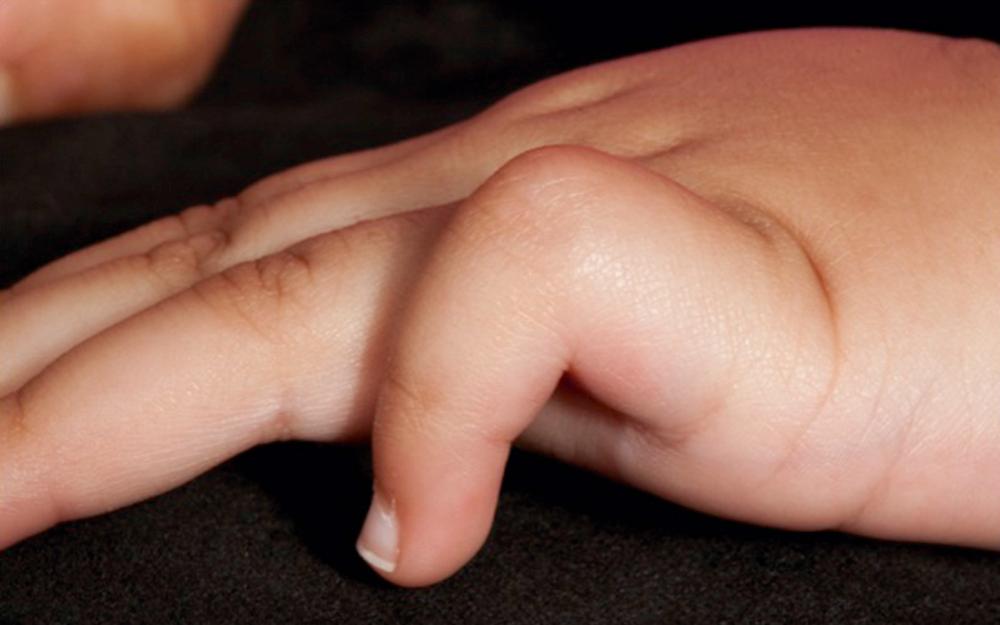
Virtually every structure crossing volar to the PIP joint has been implicated in the condition. However, abnormalities can be divided into primary causal anomalies and those that are secondary effects. The primary causes are abnormal lumbrical and flexor digitorum superficialis anatomy. Tightness and aberrant distal insertions lead to a flexor–extensor imbalance. Secondary effects include abnormalities of the retinaculum cutis, volar plate, collateral ligaments lateral bands, central slip, and skeletal changes. Skeletal changes such as joint space narrowing, flexion of the proximal phalangeal head, and flattening of the base of the middle phalanx auger a poorer response to treatment and prognosis ( Fig. 45.9 ).
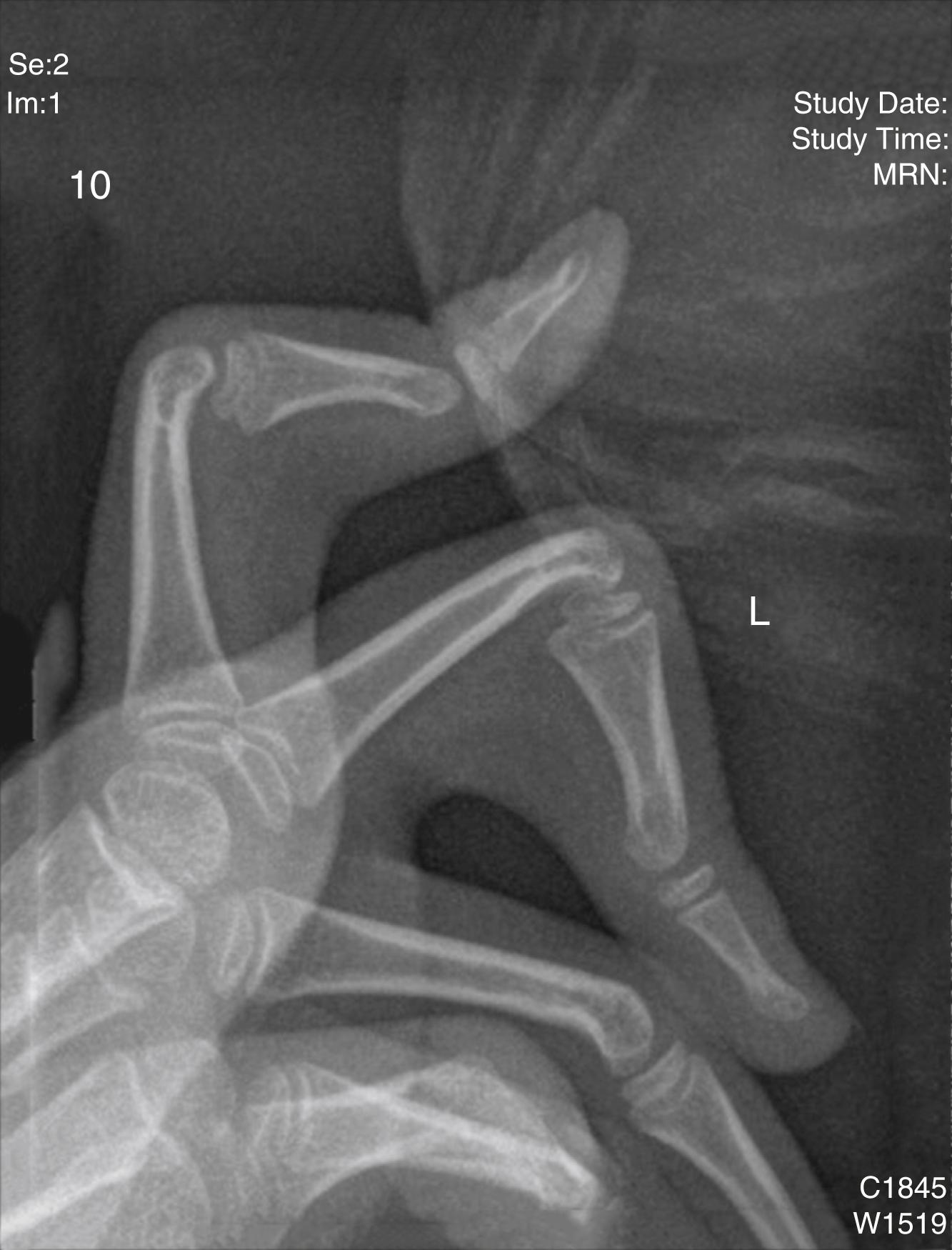
Functional impairment can occur when the flexion contracture exceeds 60 degrees and multiple digits are involved. Otherwise issues tend to be more cosmetic. Foucher described four types ( Table 45.3 ).
| Grade | Description |
|---|---|
| Ia | Early and stiff |
| Ib | Early and correctable |
| IIa | Late and stiff |
| IIb | Late and correctable |
Factors associated with a poor response to treatment include skeletal changes, older patients (teenagers), with stiff joints and those who demonstrate poor compliance with hand therapy.
The mainstay of initial management is stretching and splintage. We reserve surgical intervention for patients with a progressive condition despite compliance to hand therapy and flexion contractures of more than 60 degrees. Outcomes from surgery range from 14% to 35% improvement. Outcomes from hand therapy in young children in the Japanese population have been excellent, with an 80%–92% improvement reported though poorer in Caucasian series (mean improvement of 40°).
All abnormal structures both primary and secondary, must be addressed. We use a volar longitudinal approach with Z-plasty lengthening as required. Steps include:
Release of the retinaculum cutis, lateral digital sheets, and Grayson’s ligaments.
Release of any abnormal insertions of the lateral bands and interossei.
The lumbricals are inspected and abnormal insertions are released.
If the flexor digitorum superficialis (FDS) is functional and traction on the lateral bands produces PIP joint extension an FDS transfer to the extensor mechanism via the lumbrical canal can be performed.
If the FDS is deficient proximally and not useable it is released.
If the flexor digitorum profundus (FDP) or FDS musculotendinous units are short but functional they can be fractionally or step-lengthened in the forearm.
Joint release may be necessary, including release of the check rein ligaments, accessory collaterals, and volar plate in turn as required.
Our preference is to avoid skeletal correction as this leads to further stiffness of the PIP joint and a poorer outcome.
However, no single procedure has proved to be universally successful. Other techniques described include Glicenstein’s subperiosteal release, angulation osteotomy and arthrodesis.
Duplication may involve the whole limb or part of a limb. Polydactyly occurs when greater than five digits or toes are present. It may occur as an isolated anomaly, either sporadic or inherited, or syndromal with a multitude of associated syndromes described. Syndromic polydactyly may occur in combinations such as radial with ulnar and may coexist with other hand and foot anomalies. The aims of surgical intervention are to improve function, especially in terms of glove and shoe fitting, and cosmesis. Upper limb polydactyly is the focus of this section.
Radial, or preaxial, polydactyly occurs in 1 in 3000 live births. It is usually unilateral and sporadic, with no associations. The expanded Wassel classification with contributions from Wood in 1978 and Hung in 1996 is generally the most widely used system ( Table 45.4 ). A significant proportion of cases may not fit completely into this classification and so additional terms such as deviation or triphalangism can be used. Chromosome 7q36, harbouring the regulatory element of the SHH protein, is implicated in the rarer dominantly inherited radial polydactyly. Typically there is some degree of hypoplasia of both duplicates with the radial usually the smaller of the two (see Fig. 45.11A ). The ulnar-innervated intrinsics to the thumb typically insert onto the ulnar-most duplicate and the median-innervated onto the radial duplicate.
| Grade | Description |
|---|---|
| Type I | Bifid distal phalanx |
| Type II | Duplicated distal phalanx (approximately 20%) |
| Type III | Bifid proximal phalanx |
| Type IV | Duplicated proximal phalanx (commonest, approximately 50%) |
| Type V | Bifid metacarpal |
| Type VI | Duplicated metacarpal |
| Type VII | Triphalangeal, in either or both thumbs (approximately 12%) |
Other anomalies may be present and so it is always important to examine all four limbs. More specifically, in radial polydactyly the thenar musculature may be hypoplastic, especially with increasing Wassel grade. The extrinsics are usually Y-shaped and asymmetrical with hypoplasia or absence involving the smallest digit. Simultaneous flexion or extension may occur with or without deviation. The joints may be stiff, hypermobile or hypoplastic. Note the presence of creases and hence the chance of active movement following surgery. There may be asymmetry of the pulps and nail beds. The first web may be tight, especially with more proximal duplications.
Our preference for timing of surgical correction is between 12 and 18 months of age as long as other more pressing comordities have been addressed. In an unbalanced duplication the thumb to be retained and reconstructed should be first determined. Different parts from each thumb may need to be used in order to provide the best complement of structures for stability and function. Careful dissection of the intrinsic and extrinsic muscles, and tendons and ligamentous structures must be carried out. Pollex abductus – an abnormal deviating radial connection between the flexor and extensor apparatus – must be looked for and divided if present to allow for unrestricted motion and growth. Preservation of an optimal neurovascular supply is important for thumb viability and the preservation of sensibility. One-stage reconstruction, including osteotomies, to ensure correct skeletal alignment is recommended.
In unbalanced distal duplications where one side is larger with a well-formed nail, excision of the deficient partner, most commonly the radial, is best. The preserved duplicate – usually the ulnar is augmented with tissue salvaged from its radial partner. Incisions are planned high in the axial line dorsal to the junction of glabrous and non-glabrous skin. The radial border of the ulnar thumb is excised to allow insetting of the flap. During the dissection, the radial nail and bone are excised, and the tendons are sectioned at the level of their division. Only one nail is preserved. A broad proximal phalangeal head can be trimmed. Residual deviation of the thumb can be corrected via a closing wedge osteotomy of the distal phalanx in type II duplications or proximal phalanx in type III. Reconstruction of a radial collateral ligament using local tissue is important in this technique.
Decision-making becomes more complex when the duplications are hypoplastic but of equivalent size (balanced type). One approach in this situation is a modified Bilhaut–Cloquet procedure using asymmetric skeletal elements from each phalanx in an effort to preserve joint surface integrity and an entire nail bed from one duplicate to avoid a nail ridge. However, this approach can still result in a broad and esthetically suboptimal thumb so the aforementioned method of retaining one duplicate and augmenting it with tissue salvaged from the other is preferred whenever possible.
Generally, the best approach for these the most common of pre-axial duplications, is the preservation of the ulnar more developed thumb and reconstruction of motion and stability using elements from its radial partner. The principles and steps are similar to those in type II reconstruction with also initial detachment and subsequent reattachment of the intrinsic muscles. Incisions are planned around the radial duplicate to be excised, preserving skin to allow for soft tissue recontouring of the retained thumb. Decisions around which duplicate to retain becomes more complex in a balanced duplication ( Fig. 45.10 ). Skeletal work is often necessary to achieve long-term correction of alignment. The bifid head of the metacarpal must be trimmed to prevent residual exostosis distorting the radial contour of the reconstructed thumb. An additional osteotomy of the metacarpal may be necessary to correct any residual clinodactyly. This involves the removal of a triangular wedge of metacarpal neck to create a perpendicular articular surface. The osteotomy is fixed with a longitudinal K-wire and the radial collateral ligament should be reconstructed if possible. The latter may not be possible due to the extensive dissection required for skeletal realignment, and stability relies upon correct reinsertion of intrinsic musculature in particular the abductor digiti minimi.
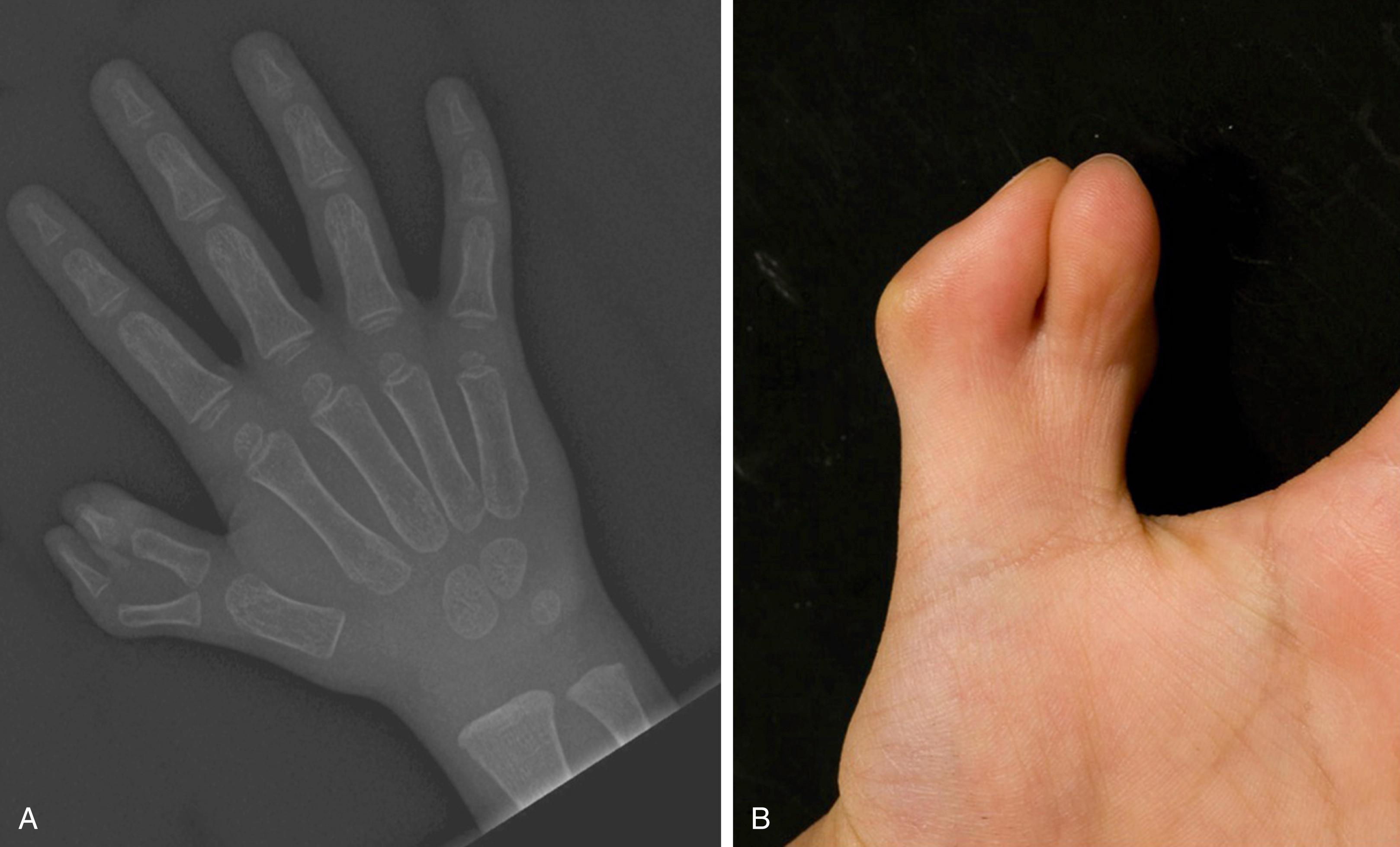
The basic principles outlined above apply to those of type V, VI, and VII duplications. The ulnar more developed thumb is usually retained and reconstructed ( Fig. 45.11 ). The intrinsic muscles must be repositioned, the lax radial collateral ligament must be tightened and the extrinsic tendons centralized if necessary. Adduction contractures in the first web must also be released to improve function. In type VI duplications where both the metacarpophalangeal (MCP) and carpometacarpal (CPC) joints are abnormal an epiphyseal-sparing chondrodesis at the MCP joint will provide the necessary stability for a functional thumb. In type VII duplications the thumb with the two phalanges is retained if it is the more stable and components of the triphalangeal duplicate used for reconstruction. If the thumbs are comparable in size and functionality then preference should be given to that with the more stable ulnar collateral ligament at the MCP joint. In some instances triphalangeal thumb reconstruction may require an on-top-plasty whereby the distal portion of one thumb is transferred to the proximal part of the other with the better basal joint.
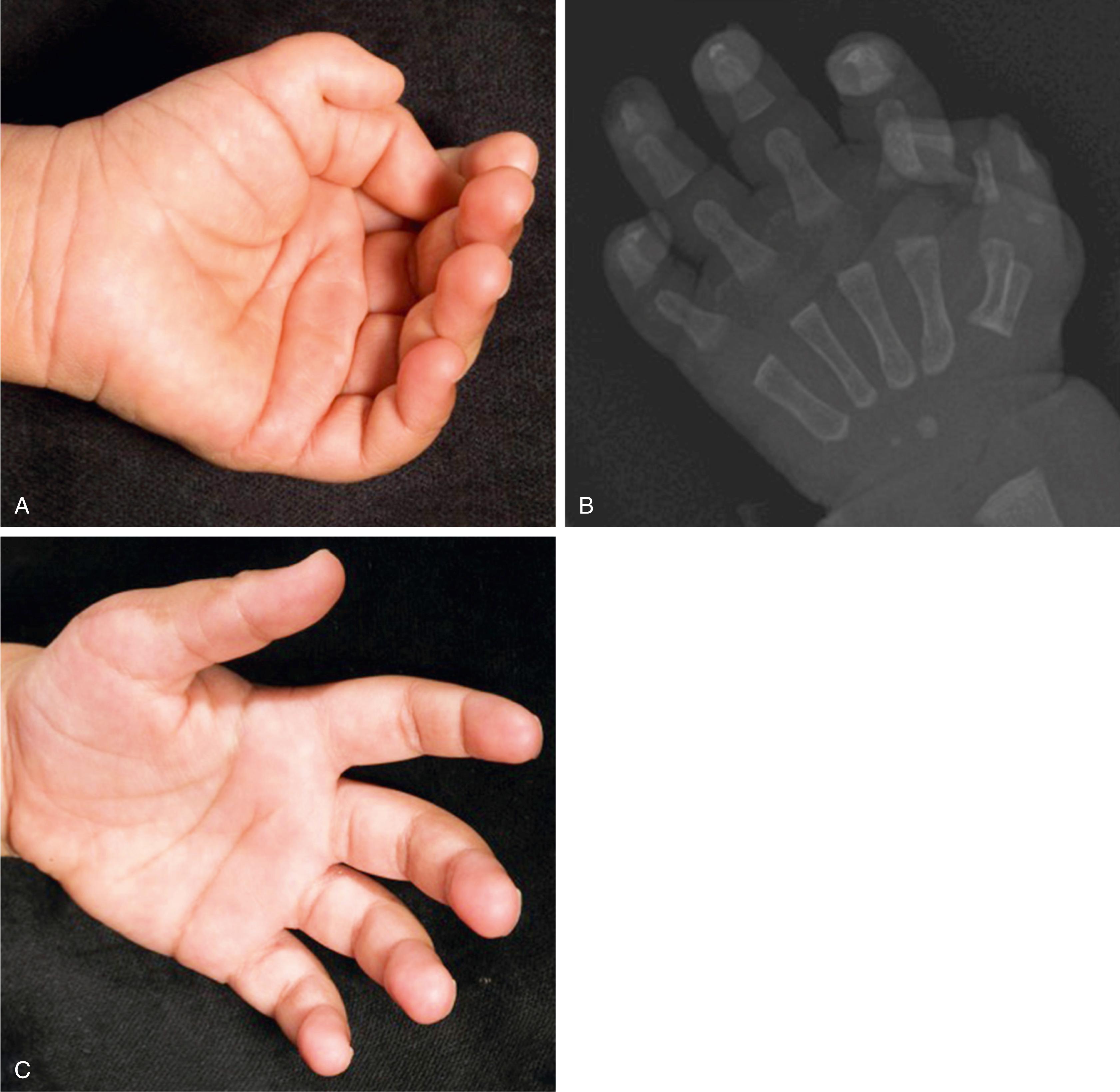
Ulnar, or postaxial, polydactyly occurs in 1 in 500 live births. It is the most common congenital hand anomaly. It is often bilateral and usually of autosomal dominant inheritance. Temtamy and McKusick in 1969 divided ulnar polydactyly into type A duplications, which were more developed and substantial, and type B, which were rudimentary and pedunculated. Type B are ten times more common in the African population. Whereas type A is rarer and its incidence is more common across races. Ulnar polydactyly, in particular the more substantial type A, is associated with a number of different syndromes, especially in Caucasian and Asian populations. These include chromosomal abnormalities such as Trisomy 13 and 18 and bone dysplasias such as Ellis–Van Creveld.
Become a Clinical Tree membership for Full access and enjoy Unlimited articles
If you are a member. Log in here